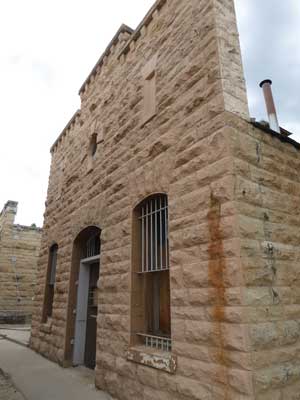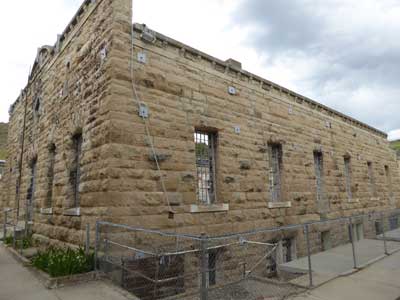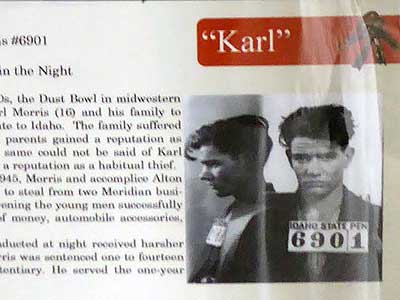BOISE (Day 5 - part 7)


Born in 1887, Benjamin's mother died when he was 2 years old. He was a musician, played in an orchestra and toured with circuses. At one point, he and another band member both liked the same woman. While drunk and on a train, he picked a fight with him and others. Benjamin shot at him and jumped off the train. Fortunately the man survived so the charge was only assault. He was sentenced for 1 - 2 years. He began the first prison bass band.
Jack was born in 1887 and arrived in Idaho around 1909. In 1914, he was arrested for an unknown offense. Jack stole the Marshal's pistol and escaped to a passenger train. When a man tried to talk him down, Jack fired at him, puncturing his lung. He was sentenced to 6 - 14 years. In 1915, he tried to kill a fellow prisoner using a shank he'd made from a barrel hoop. In 1919, he threatened another inmate. He was sent to the Idaho State Insane Asylum. In 1920, he escaped and then served prison time in Wyoming and Utah. In 1927, he returned to Idaho to serve the remainder of his sentence. He was pardoned in 1931 in the condition that he live with his mother in Texas. He later committed crimes in Arkansas and Colorado.


Bill and his brother John arrived in New York City from Greece in 1912. John got married and the three of them moved to Idaho. In 1915, John got sick. Two fellow Greek men began harassing the wife, trying to convince here to leave her husband and live as a prostitute in Salt Lake City. When she refused, they sent her poisoned candy. Bill confronted the men in a pool room. He stabbed one in the chest. The other swung a chair at him, breaking his finger, but Bill managed to stab him as well. Both died. The prosecutor called for Murder in the First Degree and the death sentence, but Bill claimed self-defense. He was sentenced 5 - 10 years and served 2 before being released.
Maggie was born in 1879. He mother passed away when she was a child and she left home at 13. In 1915, the man she'd been living with left her. She asked him to return to her but when he refused, she shot and killed him. She was sentenced to 5 - 10 years. She was released after 1 year 5 months.



Kenneth was born in 1846 in Scotland and came to the US in 1869 through Ellis Island. He arrived in Idaho sometime around 1900. He as known and a 'vicious and dangerous' drunk. In 1923, he was fired from the railroad company for being drunk. He believed a coworker had turned him in. So in 1923, drunk yet again, he killed the man. Police found marks made by his peg leg in the dirt around the body. He was sentenced t 20 - 40 but died in prison in 1933 at the age of 87 of natural causes.
Jesus Mehan was born in Colorado in 1868. He moved to Idaho in 1904, got married and had 4 kids. His wife died and he remarried Rebecca, who was 27 years younger than him. In 1921, they attended a Mexican dance. After the dance, while everyone was quite intoxicated, Rebecca began to argue with a man. She pulled out a gun and shot him 3 times. J.M. also pulled a gun and shot the man once in the head. Rebecca also accidentally shot J.M. in the abdomen during the scuffle. Both were arrested and charged with Murder in the 1st Degree. During the trial, it was uncovered the man was Rebecca's ex-lover before the marriage. He received life while she got 25 - 50 years. In an appeal, his lawyer claimed he was a victim of circumstance. He was pardoned after only 2 years. Rebecca was also released at the same time but deported back to Mexico because she wasn't a US citizen.


Prohibition started in Idaho in 1916, 4 years before the rest of the country. Supporters believed the laws ensured morals, a better family life and stopped drunken men from becoming abusive fathers and husbands. Rather than eradicating alcohol problems, however, prohibition caused more crime. In 1928 alone, 702 people were arrested in Idaho for violating the new laws. In 1933, prohibition was repealed due to increased prison populations, cultural shifts and the Great Depression.


Walter was born in 1886 and left home at 16. He was arrested for Assault in Washington in 1903 and in Oregon in 1904. In 1916, he was caught making illegal liquor. In 1917 he was caught carrying whiskey. He was sentenced to 1 - 2 years.
Sam (Simon) was born in Spain in 1883. He arrived at Ellis Island in 1907, In 1919, sam was found hiding 30 quarts of liquor under the floorboards of his chicken coop and sacks buried in the yard. He served 90 days and paid a $350 fine. He was arrested again in 1920 for having even more stashed alcohol. He served 1 year in prison, during which time his 8-year-old daughter died. Sam became a productive citizen, dying at the age of 90 in a nursing home.


Born in 1885, Roy held a wide number of jobs. In 1911, he was arrested in California for Grand Larceny. In 1917, he was arrested in Idaho for the Sale of Intoxicating Liquor but never served time. In 1920, a serious car accident left him with a shattered spine, making it difficult to move and impossible for him to work. In 1922, he was caught with several others (including the sheriff's deputy) and arrested for Conspiracy to Sell Intoxicating Liquor, but Roy made a deal to testify against the others. However, in 1923, he was arrested yet again for transporting liquor in his own vehicle. He was sentenced to 1 - 3 years. After his release, he was arrested in California for disturbing the peach, and in Boise in 1935 for vagrancy.
Helen was born in 1898. Other than being divorced, little was known about her early life. In Idaho, she reportedly operated a "house of ill fame". In 1932, she gave a 19-year-old some whisky for wiping the dust off her car. She was sentenced for 6 months - 2 years. She asked the warden for a pardon since she needed to take care of her 78-year-old mother. She only had to serve her minimum sentence.

In 1917, Idaho was the first state to pass a law against Criminal Syndicalism. This made labor violence and some anti-government speech a crime. It mostly targeted the labor unions which, sometimes violently, fought for the rights of workers. 31 men were convicted and sent here... some for simply passing out pamphlets, others for refusing to work. In 1925, the law was amended and no on was every charge with it again.


In 1973, 6 women were hired as guards. Officials hoped the presence of women would help the inmates re-socialize. The male officers complained, saying the women received the preferred positions because they could not be left alone with male inmates... so the women were released from their jobs.


Many of the staff had backgrounds in law enforcement and the armed services.
This building served as the commissary, carpenter and blacksmith shops, and eventually was the Captain's Shack (office of the Captain of the Yard).

The dining hall (built in 1898) was burned down in the 1973 riot. The kitchen and dining area were on the ground floor, while a bakery, store rooms and plunge bath were located in the basement. The building was designed by an inmate. He was paroled early but committed suicide the day after his release.




Completed in 1872, this building served as the territorial prison, receiving its first 11 inmates from the Boise County jail. In 1942, it became the chapel, until its destruction in the 1973 riot. The prison closed shortly afterwards.


(left) On the left of the photo is the burned out territorial prison/chapel; hidden partially behind it on the right is the commissary, and on the far right is the trusty dorm.


Called the New Cell House or #1 House, this building was constructed in 1890 due to the overcrowded condition of the territorial prison. There were three tiers of 42 steel cells. The second floor cells housed female inmates until 1905. The third tier closest to the rose garden served as Death Row. Of the 10 executions, 6 occurred in the garden area.




(left) Note the rose garden behind the building
Construction on the #2 Cell House (also known as the North Wing) began in 1899 and was completed in 1911. With the capacity to hold 160 men, in 2-man cells, it doubled the capacity of the prison. It was used until the late 1960s.









A cell ... the vent for the "honey bucket"
There was no indoor plumbing here. For toilets, inmates used "honey buckets" stored in the ventilation shafts at the rear of each cell. Each morning they disposed of the waste in a privy.
1994 warden's report: "Men are locked in their cells at 5:30 pm and remain in there for 14 hours. When the cells were unlocked in the early morning, the stench was unbearable. There is no reason for such revolting conditions in the 20th century."
Some of the youngest inmates:


In 1902, Charles (17) began his 1-year sentence for grand larceny. In 1903, Dee (15) arrived for stealing a horse. Gaining trusty status, the boys worked together cleaning the administration building. One time, the failed to return to their cells, instead making a dash for freedom. They were caught two days and 20 miles later, hiding in a haystack. Instead of being sent to reform school, the judged added an extra year to their sentences.
At the age of 15, Fred was accosted by two brothers who believed he had stole from them. During the fight, he killed one of them with a 20-gauge shotgun. He claimed the boy had come at him with an ax. He served 16 months.



In the late 1930's, Karl (aged 16) and his family were forced to evacuate the Dust Bowl in the midwest and relocated to Idaho. While his parents remained hard-workers, Karl became a thief. With an accomplice, he stole money, cigarettes and car accessories from two business. Burglaries conducted at night received harsher sentences... from 1 - 14 years. He served the 1 year minimum.
At the age of 11, James (Jimmie) shot and killed his mother at close range after she disciplined him for disobeying her command to do laundry work. His charge was 2nd Degree Murder. Baseball seemed to clam his anger, so the warden purchased a mitt for him. His cell mate helped teach him self-control.


Clarence served 3 sentences here. His first string of burglaries in 1903, at the age of 11, landed him in the county jail. He and an accomplice dug their way out until they were caught after several days and sent to reform school. He was sent to jail again at 17, again for burglary. During an escape attempt, he damaged the cell (Injuring a Public Jail) and was transferred here for 18 months. He returned here in 1913, for wounding an officer attempting to arrest him on forgery charges. In 1921 he served time for grand larceny, escaped in 1923 and spent 3 years on the run before recaptured. He was finally pardoned in 1931.
return • continue

